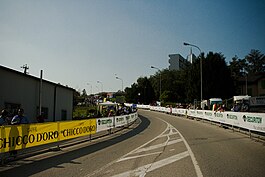Novazzano
| Novazzano | ||
|---|---|---|
 |
||
|
||
| Coordinates: 45°51′N 8°59′E / 45.850°N 8.983°ECoordinates: 45°51′N 8°59′E / 45.850°N 8.983°E | ||
| Country | Switzerland | |
| Canton | Ticino | |
| District | Mendrisio | |
| Government | ||
| • Mayor |
Sindaco Adriano Piffaretti |
|
| Area | ||
| • Total | 5.18 km2 (2.00 sq mi) | |
| Elevation | 345 m (1,132 ft) | |
| Population (Dec 2015) | ||
| • Total | 2,400 | |
| • Density | 460/km2 (1,200/sq mi) | |
| Postal code | 6883 | |
| SFOS number | 5260 | |
| Surrounded by | Balerna, Bizzarone (IT-CO), Chiasso, Coldrerio, Genestrerio, Mendrisio, Ronago (IT-CO), Uggiate-Trevano (IT-CO) | |
| Website |
novazzano SFSO statistics |
|
Novazzano is a municipality in the district of Mendrisio in the canton of Ticino in Switzerland.
Novazzano is first mentioned in 875 as Nepotiano. In 1152 it was mentioned as Novezano.
Novazzano been inhabited since the Roman era, in Castel di Sotto Roman altar fragments have been found. During the Middle Ages Novazzano belonged to the county of Seprio. It was first mentioned as a municipality in 1335. In 1567, the village separated from the political and religious authority of the Pieve of Balerna, to become an independent parish.
The parish church of SS Quirico e Giulitta (in the 13th Century known as SS Giovanni e Quirico) is first mentioned in 1330, but is of older origin. The romanesque clock tower is from the 12th Century. It was rebuilt in 1776-79 and renovated in 1998-99. During the 1998-99 renovation, an archaeological investigation was done around the church.
The local economy was once dominated by agriculture, but in the 1950s it experienced strong industrial development with an associated strong population growth. In 2005, the manufacturing sector provided more than half of the jobs, many of which were filled by commuters. A precision foundry in the municipality has about 500 employees. In 2000, about three-quarters of workers were commuters.
Novazzano has an area, as of 1997[update], of 5.18 square kilometers (2.00 sq mi). Of this area, 2.78 km2 (1.07 sq mi) or 53.7% is used for agricultural purposes, while 1.71 km2 (0.66 sq mi) or 33.0% is forested. Of the rest of the land, 1.27 km2 (0.49 sq mi) or 24.5% is settled (buildings or roads), 0.01 km2 (2.5 acres) or 0.2% is either rivers or lakes and 0.06 km2 (15 acres) or 1.2% is unproductive land.
Of the built up area, industrial buildings made up 2.7% of the total area while housing and buildings made up 12.7% and transportation infrastructure made up 5.6%. Power and water infrastructure as well as other special developed areas made up 2.3% of the area while parks, green belts and sports fields made up 1.2%. Out of the forested land, 28.8% of the total land area is heavily forested and 4.2% is covered with orchards or small clusters of trees. Of the agricultural land, 32.4% is used for growing crops, while 8.5% is used for orchards or vine crops and 12.7% is used for alpine pastures. All the water in the municipality is flowing water.
...
Wikipedia




